Optimising Hollow-Structured Silicon Nanoparticles for Lithium-Ion Batteries
Abstract
:1. Introduction
2. Experimental Details
2.1. Material Fabrication
2.2. Material Characterisation
2.3. Electrochemical Measurements
3. Results and Discussion
3.1. X-ray Photoelectron Spectroscopy
3.2. X-ray Powder Diffraction
3.3. Scanning Electron Microscope
3.4. Dynamic Light Scattering
3.5. Half-Cell and Full-Cell Cycling Test
4. Conclusions
Supplementary Materials
Author Contributions
Funding
Institutional Review Board Statement
Informed Consent Statement
Data Availability Statement
Conflicts of Interest
References
- Franco, A.A.; Rucci, A.; Brandell, D.; Frayret, C.; Gaberscek, M.; Jankowski, P.; Johansson, P. Boosting Rechargeable Batteries R&D by Multiscale Modeling: Myth or Reality? Chem. Rev. 2019, 119, 4569–4627. [Google Scholar]
- Kalair, A.; Abas, N.; Saleem, M.S.; Kalair, A.R.; Khan, N. Role of energy storage systems in energy transition from fossil fuels to renewables. Energy Storage 2020, 3, e135. [Google Scholar] [CrossRef]
- Ma, D.; Li, Y.; Mi, H.; Luo, S.; Zhang, P.; Lin, Z.; Li, J.; Zhang, H. Robust SnO2−x Nanoparticle-Impregnated Carbon Nanofibers with Outstanding Electrochemical Performance for Advanced Sodium-Ion Batteries. Angew. Chem. Int. Ed. 2018, 57, 8901–8905. [Google Scholar] [CrossRef]
- Ward, J.D.; Nel, W.P. Comment on Fossil-fuel constraints on global warming by A. Zecca and L. Chiari [Energy Policy 38 (2010) 1–3]. Energy Policy 2011, 39, 7464–7466. [Google Scholar] [CrossRef]
- Knobloch, F.; Hanssen, S.V.; Lam, A.; Pollitt, H.; Salas, P.; Chewpreecha, U.; Huijbregts, M.A.J.; Mercure, J.-F. Net emission reductions from electric cars and heat pumps in 59 world regions over time. Nat. Sustain. 2020, 3, 437–447. [Google Scholar] [CrossRef]
- Heydarian, A.; Mousavi, S.M.; Vakilchap, F.; Baniasadi, M. Application of a mixed culture of adapted acidophilic bacteria in two-step bioleaching of spent lithium-ion laptop batteries. J. Power Sources 2018, 378, 19–30. [Google Scholar] [CrossRef]
- Xiao, F.; Chen, X.; Zhang, J.; Huang, C.; Hu, T.; Hong, B.; Xu, J. Large-scale production of holey graphite as high-rate anode for lithium ion batteries. J. Energy Chem. 2020, 48, 122–127. [Google Scholar] [CrossRef]
- Zhang, F.; Yi, F.; Gao, A.; Shu, D.; Sun, Z.; Mao, J.; Zhou, X.; Zhu, Z.; Sun, Y. Interfacial electrostatic self-assembly in water-in-oil microemulsion assisted synthesis of Li4Ti5O12/Graphene for lithium-ion-batteries. J. Alloys Compd. 2020, 819, 153018. [Google Scholar] [CrossRef]
- Tian, Q.; Chen, Y.; Zhang, W.; Sui, Z.; Yang, L. Reducing the excessive interior space of SnO2@C nanotubes by encapsulating SnO2 nanowires for high lithium storage. J. Alloys Compd. 2020, 820, 153404. [Google Scholar] [CrossRef]
- Tan, J.; Qi, X.; Mao, J. A novel Al@TiO2-MCMB dual-ion battery with excellent cycling performance at high current rate. J. Alloys Compd. 2020, 818, 152853. [Google Scholar] [CrossRef]
- Xu, C.; Wang, B.; Luo, H.; Jing, P.; Zhang, X.; Wang, Q.; Zhang, Y.; Wu, H. Embedding Silicon in Pinecone-Derived Porous Carbon as a High-Performance Anode for Lithium-Ion Batteries. ChemElectroChem 2020, 7, 152853. [Google Scholar] [CrossRef]
- Sun, F.; Huang, K.; Qi, X.; Gao, T.; Liu, Y.; Zou, X.; Wei, X.; Zhong, J. A rationally designed composite of alternating strata of Si nanoparticles and graphene: A high-performance lithium-ion battery anode. Nanoscale 2013, 5, 8586–8592. [Google Scholar] [CrossRef]
- Han, L.; Zhang, J.; Zou, M.; Tong, J. Toward Superb Perovskite Oxide Electrocatalysts: Engineering of Coupled Nanocomposites. Small 2022, 18, 2204784. [Google Scholar] [CrossRef] [PubMed]
- Liu, X.H.; Zhong, L.; Huang, S.; Mao, S.X.; Zhu, T.; Huang, J.Y. Size-Dependent Fracture of Silicon Nanoparticles During Lithiation. ACS Nano 2012, 6, 1522–1531. [Google Scholar] [CrossRef] [PubMed]
- Rahman, M.A.; Song, G.; Bhatt, A.I.; Wong, Y.C.; Wen, C. Nanostructure silicon anodes for high-performance lithium-ion batteries. Adv. Funct. Mater. 2016, 26, 647–678. [Google Scholar] [CrossRef]
- Ahmadabadi, V.G.; Shirvanimoghaddam, K.; Kerr, R.; Showkath, N.; Naebe, M. Structure-rate performance relationship in Si nanopartciels-carbon nanofiber composite as flexible anode for lithium-ion batteries. Electrochim. Acta 2020, 330, 135232. [Google Scholar] [CrossRef]
- Jeong, G.; Kim, J.G.; Park, M.S.; Seo, M.; Hwang, S.M.; Kim, Y.U.; Kim, J.H.; Dou, S.X. Core-shell structured silicon nanoparticles@TiO2−x/carbon mesoporous microfiber composite as a safe and high-performance lithium-ion battery anode. ACS Nano 2014, 8, 2977–2985. [Google Scholar] [CrossRef]
- Chen, J.; Yang, L.; Rousidan, S.; Fang, S.; Zhang, Z.; Hirano, S.-I. Facile fabrication of Si mesoporous nanowires for high-capacity and long-life lithium storage. Nanoscale 2013, 5, 10623–10628. [Google Scholar] [CrossRef]
- Wu, H.; Chan, G.; Choi, J.W.; Yao, Y.; McDowell, M.T.; Lee, S.W.; Jackson, A.; Yang, Y.; Hu, L.; Cui, Y. Stable cycling of double-walled silicon nanotube battery anodes through solid–electrolyte interphase control. Nat. Nanotechnol. 2012, 7, 310–315. [Google Scholar] [CrossRef]
- Liu, N.; Lu, Z.; Zhao, J.; McDowell, M.T.; Lee, H.-W.; Zhao, W.; Cui, Y. A pomegranate-inspired nanoscale design for large-volume-change lithium battery anodes. Nat. Nanotechnol. 2014, 9, 187–192. [Google Scholar] [CrossRef]
- Luo, W.; Wang, Y.; Chou, S.; Xu, Y.; Li, W.; Kong, B.; Dou, S.X.; Liu, H.K.; Yang, J. Critical thickness of phenolic resin-based carbon interfacial layer for improving long cycling stability of silicon nanoparticle anodes. Nano Energy 2016, 27, 255–264. [Google Scholar] [CrossRef]
- Yang, J.; Wang, Y.-X.; Chou, S.-L.; Zhang, R.; Xu, Y.; Fan, J.; Zhang, W.-X.; Liu, H.K.; Zhao, D.; Dou, S.X. Yolk-shell silicon-mesoporous carbon anode with compact solid electrolyte interphase film for superior lithium-ion batteries. Nano Energy 2015, 18, 133–142. [Google Scholar] [CrossRef]
- Wu, Y.-J.; Chen, Y.-A.; Huang, C.-L.; Su, J.-T.; Hsieh, C.-T.; Lu, S.-Y. Small highly mesoporous silicon nanoparticles for high performance lithium ion based energy storage. Chem. Eng. J. 2020, 400, 125958. [Google Scholar] [CrossRef]
- Liu, H.; Bi, Z.; Sun, X.-G.; Unocic, R.R.; Paranthaman, M.P.; Dai, S.; Brown, G.M. Mesoporous TiO2-B Microspheres with Superior Rate Performance for Lithium Ion Batteries. Adv. Mater. 2011, 23, 3450–3454. [Google Scholar] [CrossRef]
- Li, J.; Wang, Y.; Huang, Z.; Huang, K.; Qi, X.; Zhong, J. Synthesis of Si/TiO2 core–shell nanoparticles as anode material for high performance lithium ion batteries. J. Mater. Sci. Mater. Electron. 2016, 27, 12813–12819. [Google Scholar] [CrossRef]
- Jiang, J.; Liu, S.; Wang, Y.; Liu, Y.; Fan, J.; Lou, X.; Wang, X.; Zhang, H.; Yang, L. Auto-adjustment of structure and SnO2 content of SnO2/TiO2 microspheres for lithium-ion batteries. Chem. Eng. J. 2019, 359, 746–754. [Google Scholar] [CrossRef]
- Jin, Y.; Li, S.; Kushima, A.; Zheng, X.; Sun, Y.; Xie, J.; Sun, J.; Xue, W.; Zhou, G.; Wu, J.; et al. Self-healing SEI enables full-cell cycling of a silicon-majority anode with a coulombic efficiency exceeding 99.9%. Energy Environ. Sci. 2017, 10, 580–592. [Google Scholar] [CrossRef]
- Asenbauer, J.; Eisenmann, T.; Kuenzel, M.; Kazzazi, A.; Chen, Z.; Bresser, D. The success story of graphite as a lithium-ion anode material—Fundamentals, remaining challenges, and recent developments including silicon (oxide) composites. Sustain. Energy Fuels 2020, 4, 5387–5416. [Google Scholar] [CrossRef]
- Deng, D. Li-ion batteries: Basics, progress, and challenges. Energy Sci. Eng. 2015, 3, 385–418. [Google Scholar] [CrossRef]
- Zhang, J.-C.; Liu, Z.-D.; Zeng, C.-H.; Luo, J.-W.; Deng, Y.-D.; Cui, X.-Y.; Chen, Y.-N. High-voltage LiCoO2 cathodes for high-energy-density lithium-ion battery. Rare Met. 2022, 41, 3946–395629. [Google Scholar] [CrossRef]
- Lyu, Y.; Wu, X.; Wang, K.; Feng, Z.; Cheng, T.; Liu, Y.; Wang, M.; Chen, R.; Xu, L.; Zhou, J.; et al. An Overview on the Advances of LiCoO2 Cathodes for Lithium-Ion Batteries. Adv. Energy Mater. 2021, 11, 2000982. [Google Scholar] [CrossRef]


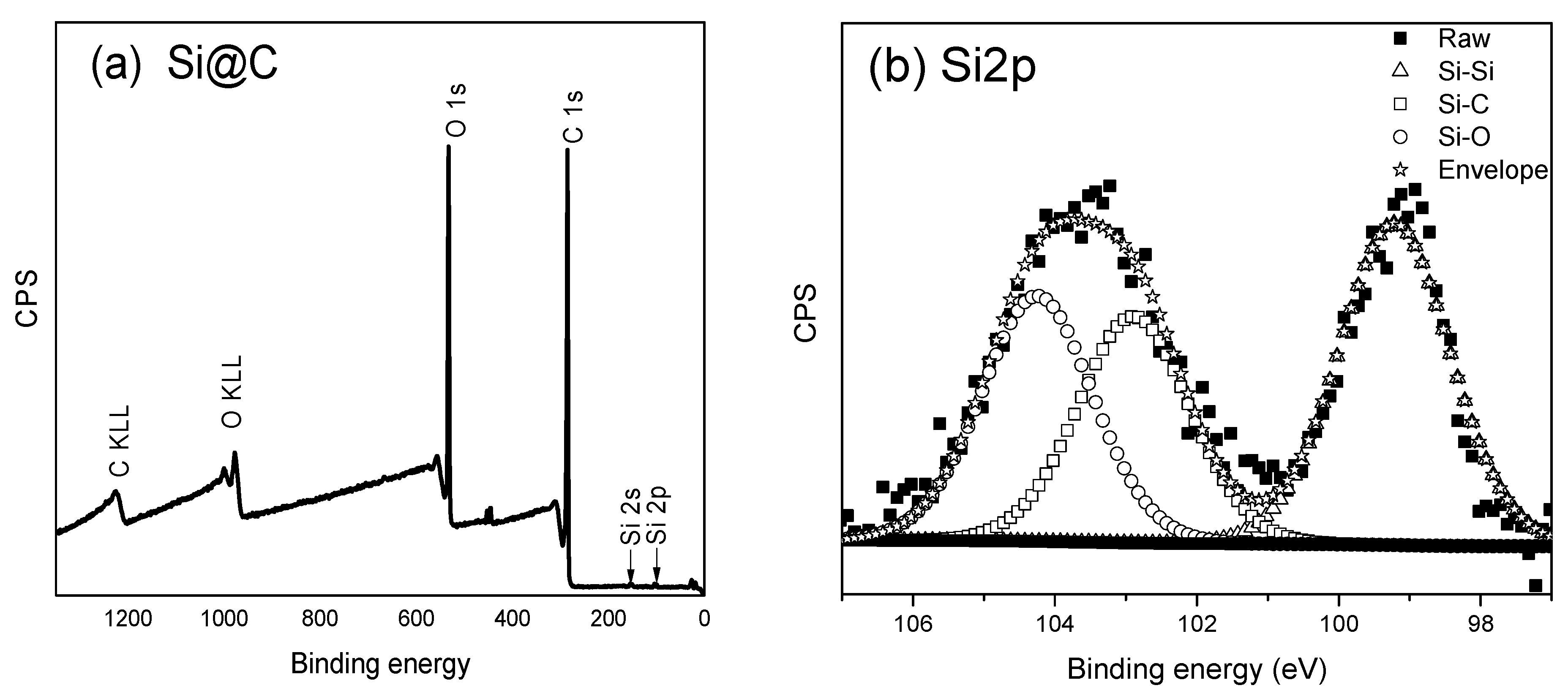
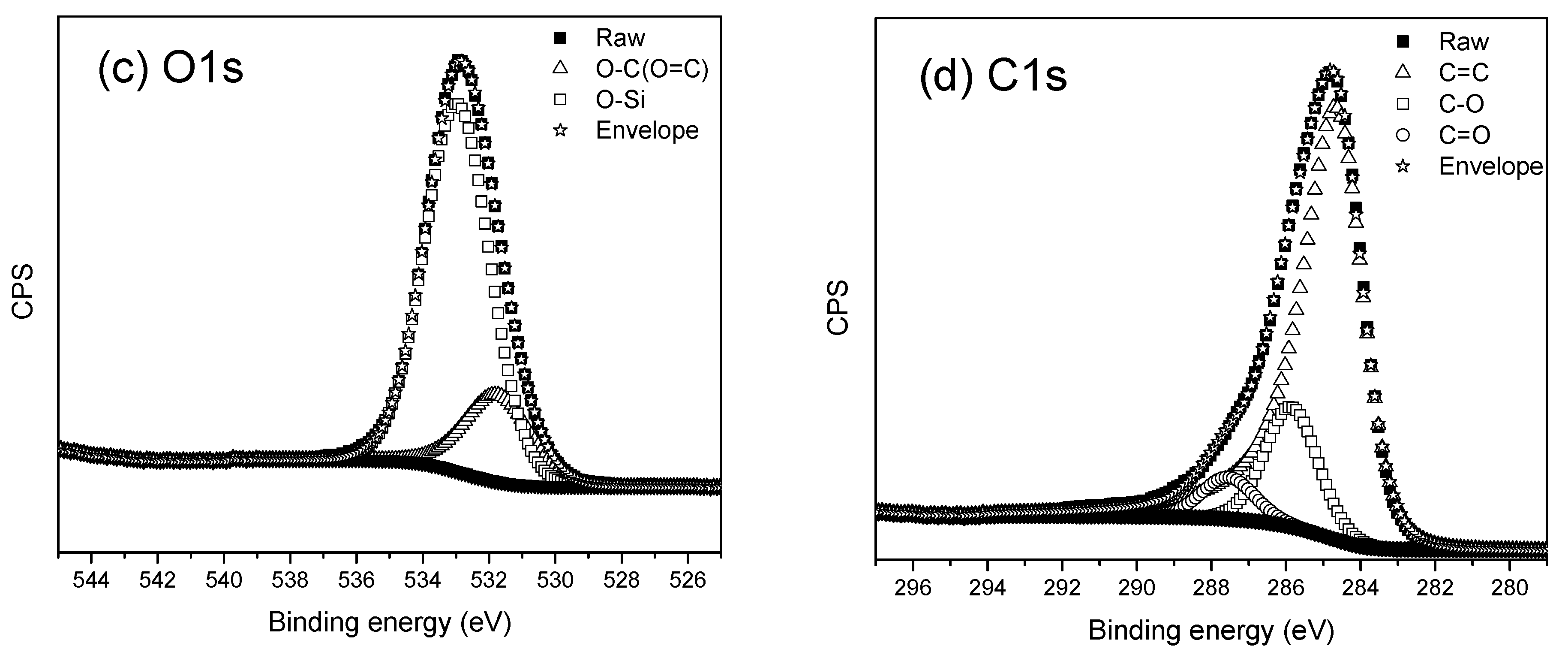
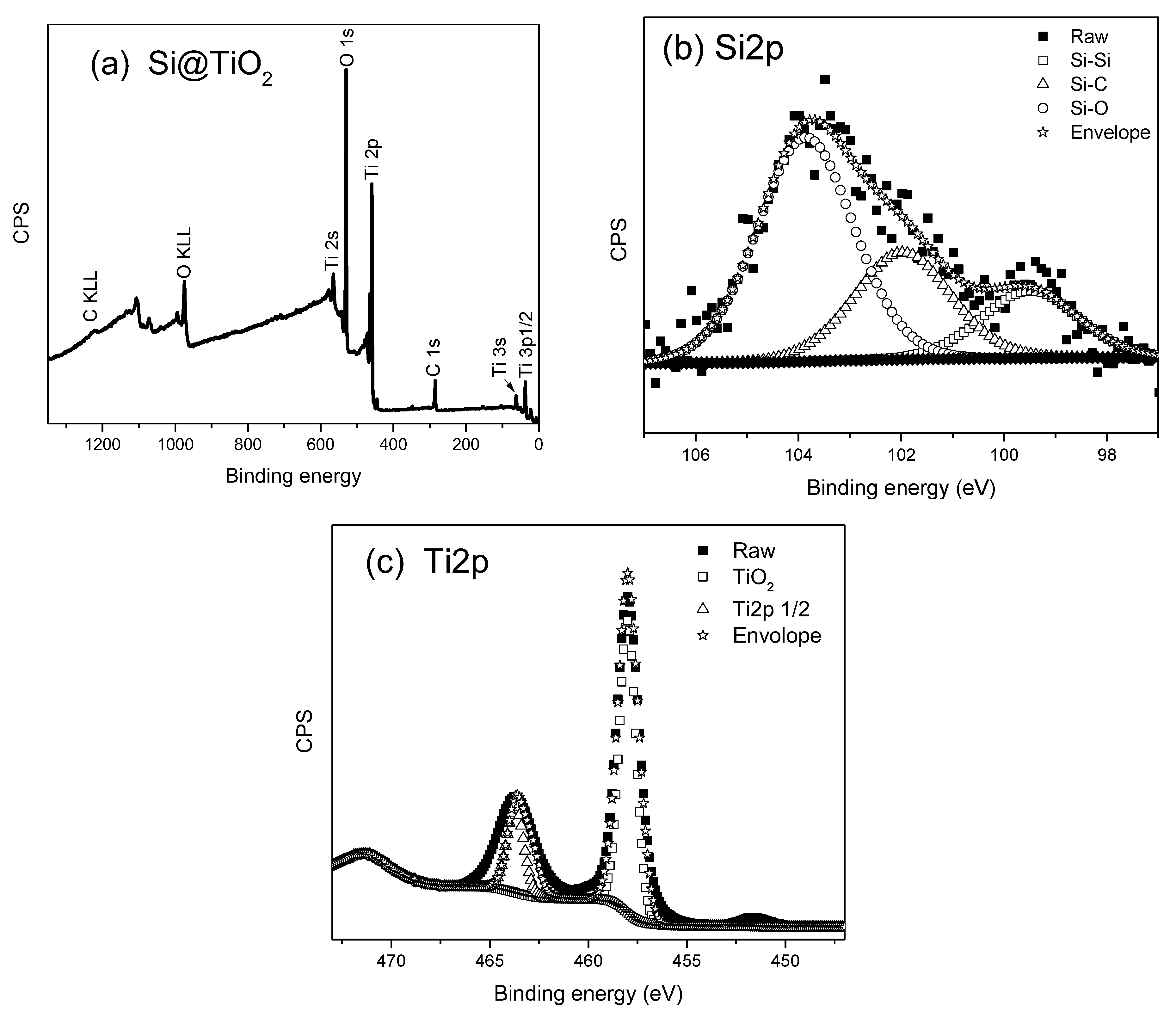





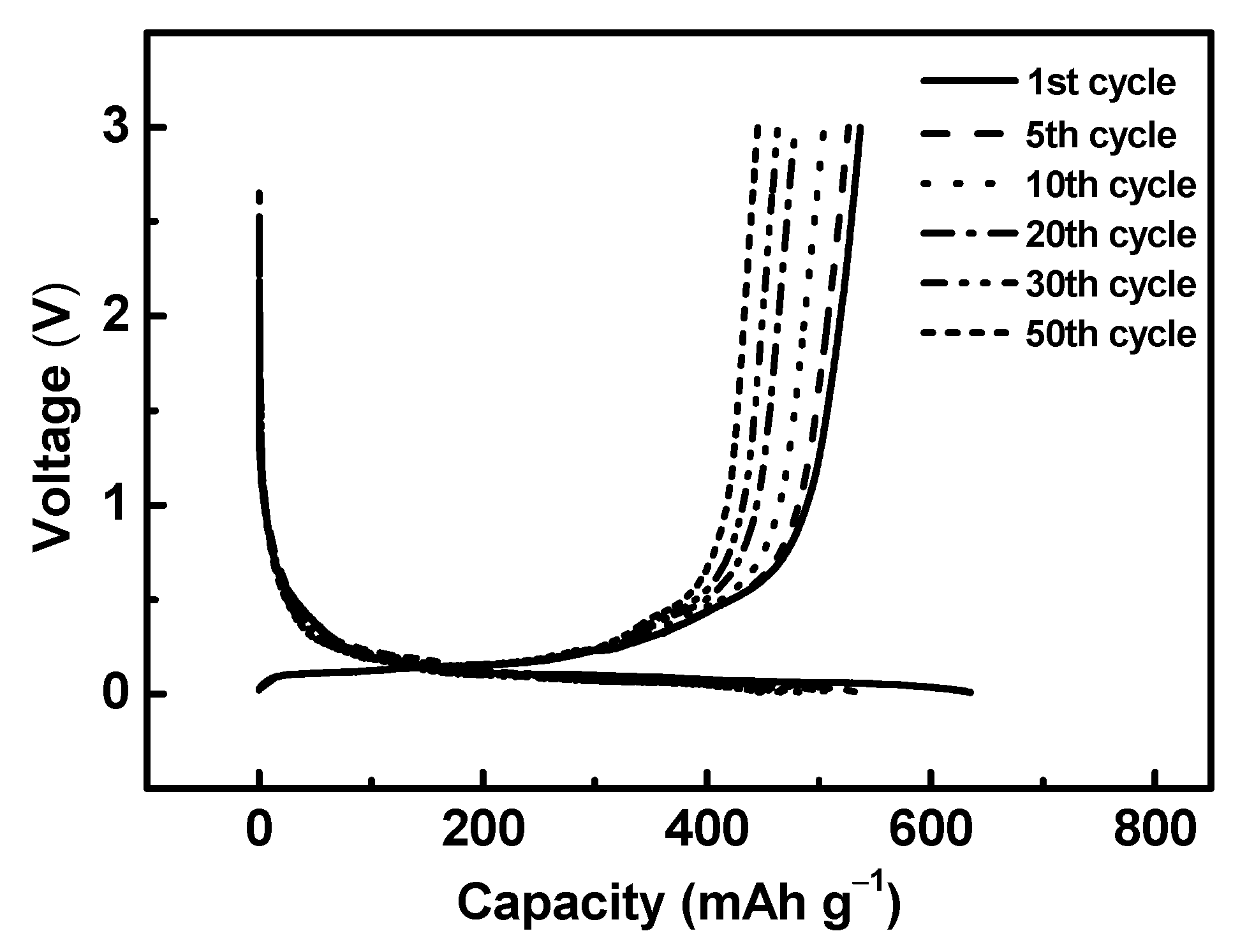
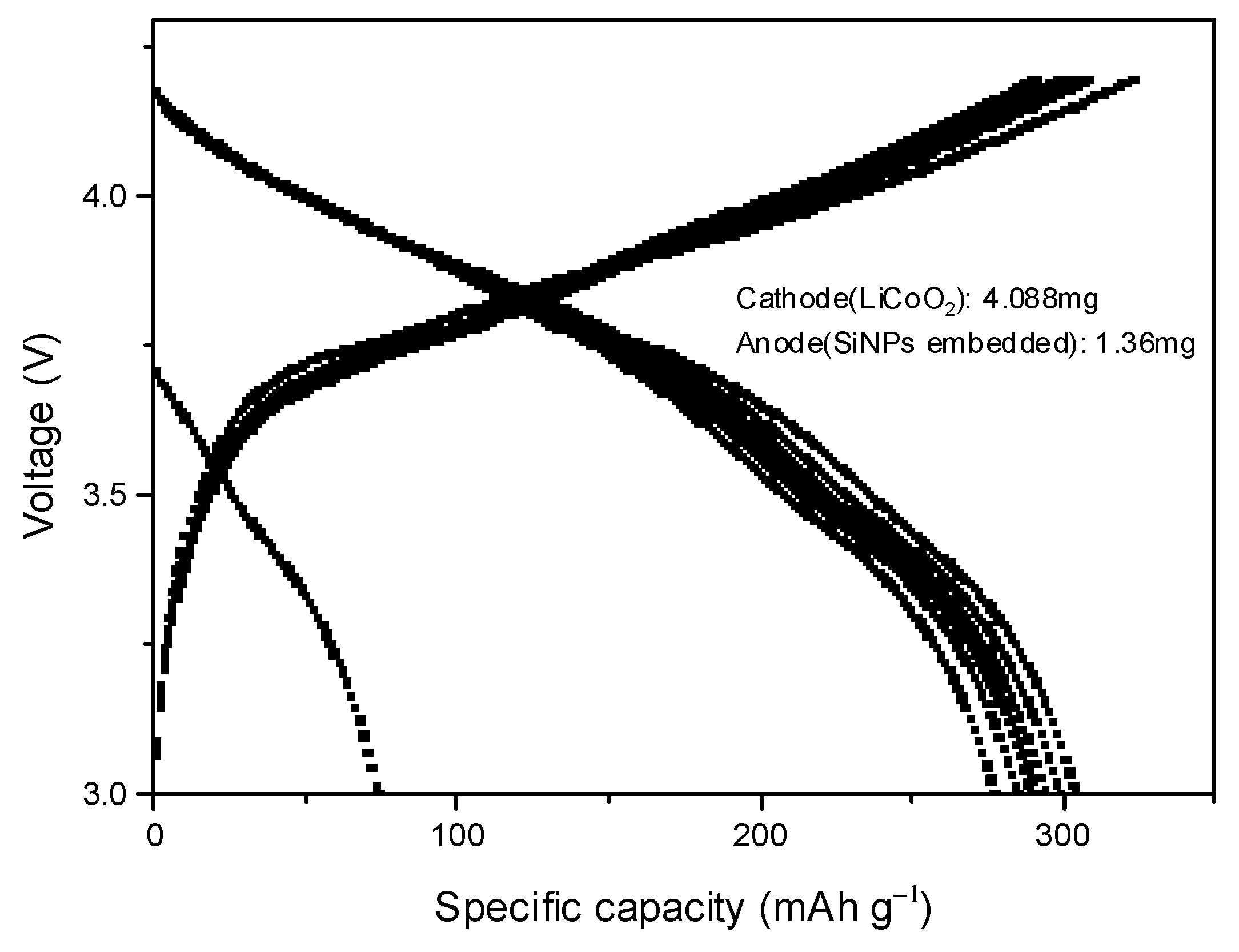
Disclaimer/Publisher’s Note: The statements, opinions and data contained in all publications are solely those of the individual author(s) and contributor(s) and not of MDPI and/or the editor(s). MDPI and/or the editor(s) disclaim responsibility for any injury to people or property resulting from any ideas, methods, instructions or products referred to in the content. |
© 2023 by the authors. Licensee MDPI, Basel, Switzerland. This article is an open access article distributed under the terms and conditions of the Creative Commons Attribution (CC BY) license (https://creativecommons.org/licenses/by/4.0/).
Share and Cite
Yue, C.; Liu, Y.; Guan, S.; Fereydooni, A.; Zeng, Y.; Wei, Z.; Wang, Y.; Chao, Y. Optimising Hollow-Structured Silicon Nanoparticles for Lithium-Ion Batteries. Materials 2023, 16, 5884. https://doi.org/10.3390/ma16175884
Yue C, Liu Y, Guan S, Fereydooni A, Zeng Y, Wei Z, Wang Y, Chao Y. Optimising Hollow-Structured Silicon Nanoparticles for Lithium-Ion Batteries. Materials. 2023; 16(17):5884. https://doi.org/10.3390/ma16175884
Chicago/Turabian StyleYue, Chenghao, Yao Liu, Shaoliang Guan, Alireza Fereydooni, Yuexi Zeng, Zhijie Wei, Yonggang Wang, and Yimin Chao. 2023. "Optimising Hollow-Structured Silicon Nanoparticles for Lithium-Ion Batteries" Materials 16, no. 17: 5884. https://doi.org/10.3390/ma16175884
APA StyleYue, C., Liu, Y., Guan, S., Fereydooni, A., Zeng, Y., Wei, Z., Wang, Y., & Chao, Y. (2023). Optimising Hollow-Structured Silicon Nanoparticles for Lithium-Ion Batteries. Materials, 16(17), 5884. https://doi.org/10.3390/ma16175884






